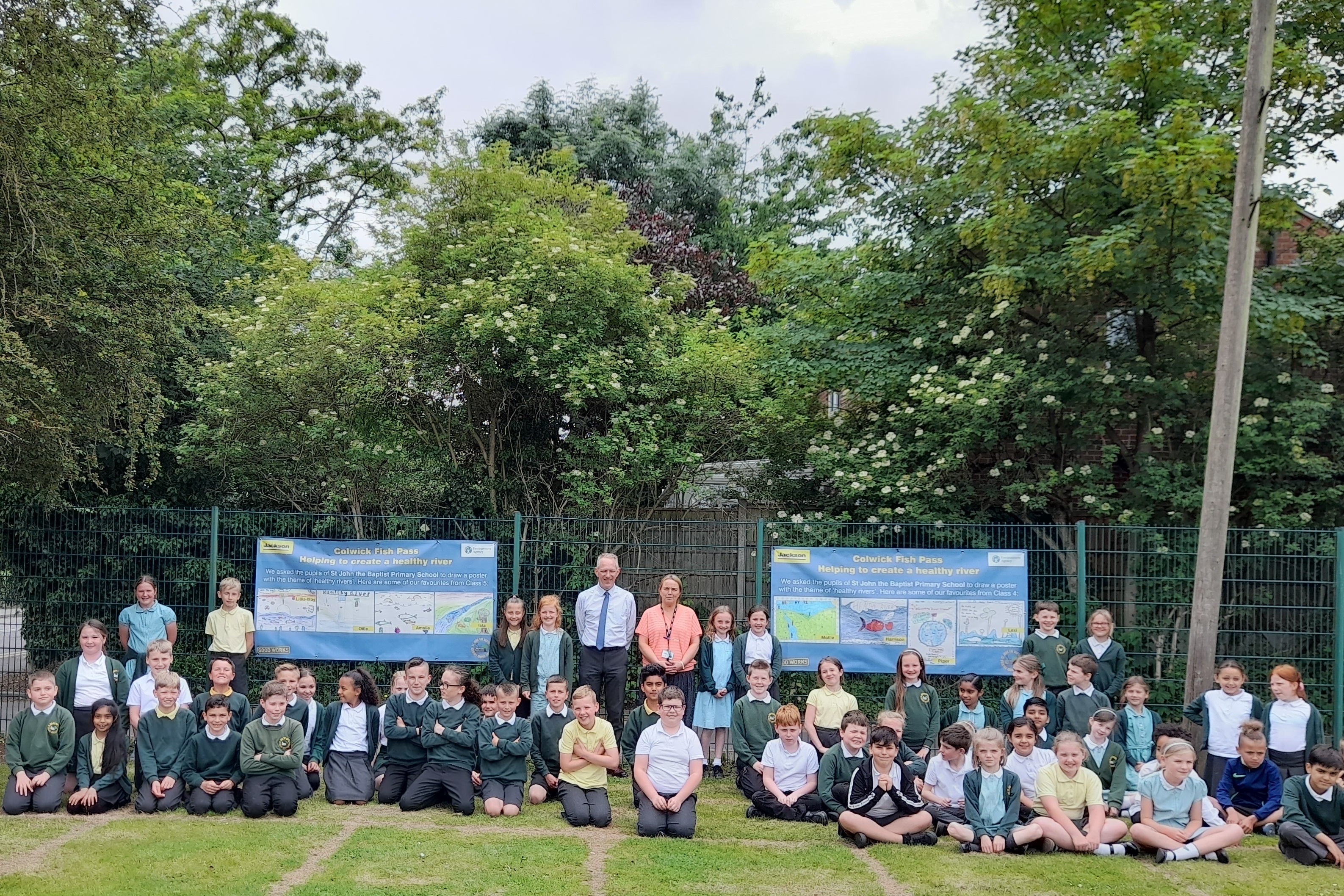
Children design ‘healthy rivers’ posters for Colwick fish pass
Published By GOV.UK [English], Wed, Jun 22, 2022 7:27 AM
Improvements for the passage of fish in the River Trent catchment, including salmon, and the creation of a healthy watercourse
Construction of the Colwick (Holme Sluices) fish pass runs until 2023. It is the first scheme of the ambitious Trent Gateway Partnership which aims to remove all barriers to fish migration along the River Trent
Children from St John the Baptist Primary School in Colwick, Nottinghamshire have designed posters under the theme of ‘healthy rivers’ for inclusion in two banners that will be erected on the site of the Colwick (Holme Sluices) fish pass, which is currently under construction.
The children in year 4 and year 5 were asked to design a poster to depict what ‘healthy rivers’ means to them as one of the aims of the nearby Colwick (Holme Sluices) fish pass is to help to create a healthy watercourse. The winners of the poster competition were chosen by the Environment Agency Project Manager, and the appointed contractors, Jackson Civil Engineering.
Once complete in 2023, the fish pass in Nottingham’s Colwick Country Park, will be the largest in the country. It will allow migratory fish to access spawning grounds upstream, provide better wildlife habitats, and improve the biodiversity of the area.
Simon Ward, Fisheries Technical Specialist at the Environment Agency, said:
Our aim is to create a healthy watercourse that not only reduces flood risk and provides better wildlife habitats but also engages local communities about the natural and social history of the river.
The schoolchildren’s poster competition run by our contractors is an excellent initiative which has succeeded in engaging the local community at an early age in our ambitions plans for the River Trent, starting with the construction of the Colwick (Holme Sluices) fish pass.
The banners are extremely eye-catching and once on display will highlight to the many visitors to Colwick Country Park our aim for the fish pass to help make the river a healthy watercourse.
There are a number of barriers to fish migration within the River Trent catchment, including Holme Sluices, which is the largest barrier to the natural migration of fish in the Midlands. By installing fish passage, it will become easier for salmon and other fish to reach their spawning and feeding grounds.
Kathryn Battelle, Public Liaison Officer at Jackson Civil Engineering, said:
It has been a pleasure working with St John the Baptist Primary School and seeing all the beautiful artwork the children created. It was extremely difficult to select winners, the standard of entry was so high. We would like to thank all the staff and children for their hard work and making us feel so welcome.
Construction of the fish pass will run until 2023. It is the first scheme of the ambitious Trent Gateway Partnership which aims to remove all barriers to fish migration along the River Trent.
Further details about the project are available on our dedicated Colwick (Holme Sluices) fish pass webpage: to the main channel of the fish pass have now started, with the piling works beginning at the end of April. Since then, over 180 sheet piles have been driven into the ground, over a quarter of the estimated 620 needed. To date all piles have been successfully completed using movax vibration piling, which has helped to keep the noise disruption to a minimum. Piling works will continue for around a further 3 months.
The Colwick (Holme Sluices) fish pass will be the largest fish pass in the country. The cost of construction is £8.5 million. The direct environmental benefits of the fish pass will be £18.6 million. This includes 60 kilometres of river improvement from poor to good status for fish, as well as 60 kilometres of new spawning habitat immediately upstream of the barrier. It will also aid interconnectivity with numerous other fish passage schemes previously constructed upstream by the Environment Agency.
Holme Sluices is a major flood risk management structure that spans the full width of the River Trent - the third longest river in the country - to the south of Nottingham and helps to protect Nottingham from flooding. It was built in the 1950s as part of a large-scale flood defence scheme.
Clearance work started in January to create additional space for construction of the Colwick (Holme Sluices) fish pass to take place. For every tree removed, 5 trees within Colwick Park and the local area will be planted, once the fish pass is complete.
Colwick Country Park is owned and run by Nottingham City Council. The Environment Agency will work with the council to make Colwick Country Park in Nottingham the hub for Trent Gateway. Future plans could include a visitor centre telling the story of the Trent, its history, ecology and how it has shaped communities along its length for centuries. Discussions have taken place with the council and Heritage Lottery Fund
The Trent Gateway project is part of the Lower Trent and Erewash Catchment Partnership, hosted by the Trent Rivers Trust, who are leading on the development of projects to further enhance the river and deliver the ambition of Trent Gateway.
30 local partner organisations, including the Environment Agency, have been developing the ambitious project to restore the River Trent and reconnect communities and wildlife within it.
Press release distributed by Media Pigeon on behalf of GOV.UK, on Jun 22, 2022. For more information subscribe and follow